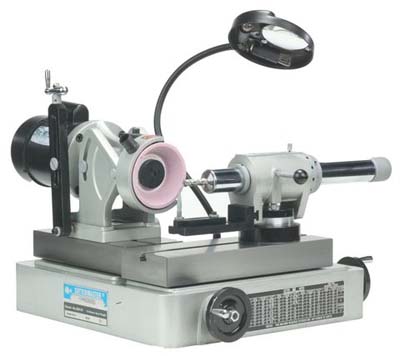Cuttermaster Tool Sharpener
Cuttermaster Tool Sharpener
Eliminate regrind bills and save money, reduce your tool crib inventory and save more money with tool resharpener from Conquest Industries.

Eliminate regrind bills and save money, reduce your tool crib inventory and save more money with tool resharpener from Conquest Industries. Razor sharp cutting tools give you peak performance at all times. Perform gashing and sharpen your cutting tools the way you want with special clearance angles. Keep your machining centers running sharper tools so you can run continuously at optimum speeds and experience less down time that is draining your cash flow.
One machine does it all: spiral router bits, end mills, roughing end mills, radius end mills, milling cutters, carbide tools, and countersinks, engraving tools, lathe and form tools including reamers.
Accessories are available such as pneumatic fingers to cut sharpening time in half automatically adjusting clearance angles. A universal grinding fixture is available for gashing, to grind spade drills and can quickly adjust point clearance including radius lip grinding. Most everything with indexing or reliefs can be ground sharper whether left hand or right handed. Taper attachments are available for taper reamer and other taper applications. The Work Holding Fixture has 4 quadrants ideal for form or flat tools having compound angles.
The CUTTERMASTER Motor or Grinding wheel tilts to +35 to -8 degrees. The X-Axis has a hardened and ground lead screw with dovetail ways and has adjustable gibs traveling to 6-inches in 0.001-inch graduations. The Y-Axis has the same construction traveling to 9-Inches in 0.001-inch graduation. Flute length capacity using 5C collets using 1-¼" shank diameter and under is to 10.5 inches. Flute length capacity using end mill holder with 1-¼, 1-½ or 2 inch shanks is 8-inches. The Z-Axis vertical lift is 3-¾ inches with 180 degree motor swivel and has eight working axes for sharpening roughing end mills, chip breakers, fluting and gashing in minutes.
This Made in America CUTTERMASTER TOOL and END MILL SHARPENER is available with a LEESON 1⁄3 HP, 110 Volt (2.2 AMP, 3450 RPM) or 220 Volt (2.4 AMP, 2850 RPM) Motor retailing for $3360.





